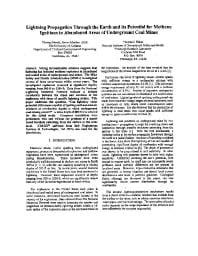Mining Publication: Lightning Propagation Through the Earth and its Potential for Methane Ignitions in Abandoned Areas of Underground Coal Mines
Original creation date: October 2002
Authors: T Novak, TJ Fisher
NIOSHTIC2 Number: 20021028
Conference Record of the 2000 IEEE Industry Applications Conference - 35th IAS Annual Meeting and World Conference on Industrial Applications of Electrical Energy, Rome, Italy, 2000 Oct; :1-3, Pitscataway, New Jersey: IEEE 2002 Oct; :2674-2681
Strong circumstantial evidence suggests that lightning has initiated methane explosions in abandoned and sealed areas of underground coal mines. The Mine Safety and Health Administration (MSHA) investigated several of these occurrences within recent years. The investigated explosions occurred at significant depths, ranging from 500 ft to 1200 ft. Data from the National Lightning Detection Network indicate a definite correlation between the times and locations of the explosions with those of specific lightning strikes. This paper addresses the question, 'Can lightning cause potential differences capable of igniting methane-and-air mixtures at overburden depths at which underground coal mining occurs?' A mine depth of 600 ft was selected for this study. Computer simulations were performed, with and without the presence of a metal-cased borehole extending from the surface to the mine level. CDEGS software from Safe Engineering Services & Technologies, Ltd (SES) was used for the simulations.

NIOSHTIC2 Number: 20021028
Conference Record of the 2000 IEEE Industry Applications Conference - 35th IAS Annual Meeting and World Conference on Industrial Applications of Electrical Energy, Rome, Italy, 2000 Oct; :1-3, Pitscataway, New Jersey: IEEE 2002 Oct; :2674-2681
- Control of Longwall Gob Gas With Cross-Measure Boreholes (Upper Kittanning Coalbed)
- Development and Application of Reservoir Models and Artificial Neural Networks for Optimizing Ventilation Air Requirements in Development Mining of Coal Seams
- Effect of a Surface Borehole on Longwall Gob Degasification (Pocahontas No. 3 Coalbed)
- Ignition of Methane-Air Mixtures by Laser Heated Small Particles
- Laser Ignition of Flammable Gas
- Methane-Air Mixtures Ignited by CW Laser-Heated Targets on Optical Fiber Tips: Comparison of Targets, Optical Fibers, and Ignition Delays
- A Methodology for Determining Gob Permeability Distributions and its Application to Reservoir Modeling of Coal Mine Longwalls
- Modeling and Prediction of Ventilation Methane Emissions of U.S. Longwall Mines Using Supervised Artificial Neural Networks
- Probabilistic Modeling Using Bivariate Normal Distributions for Identification of Flow and Displacement Intervals in Longwall Overburden
- Underground Gob Gas Drainage During Longwall Mining